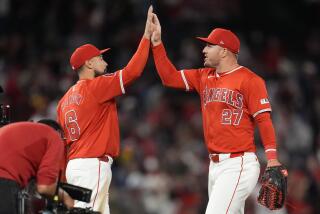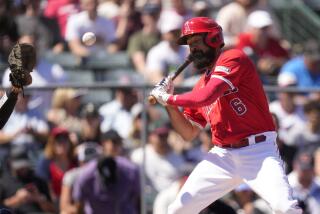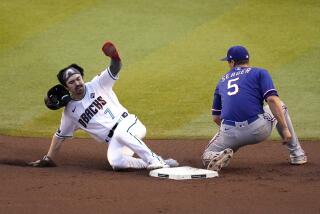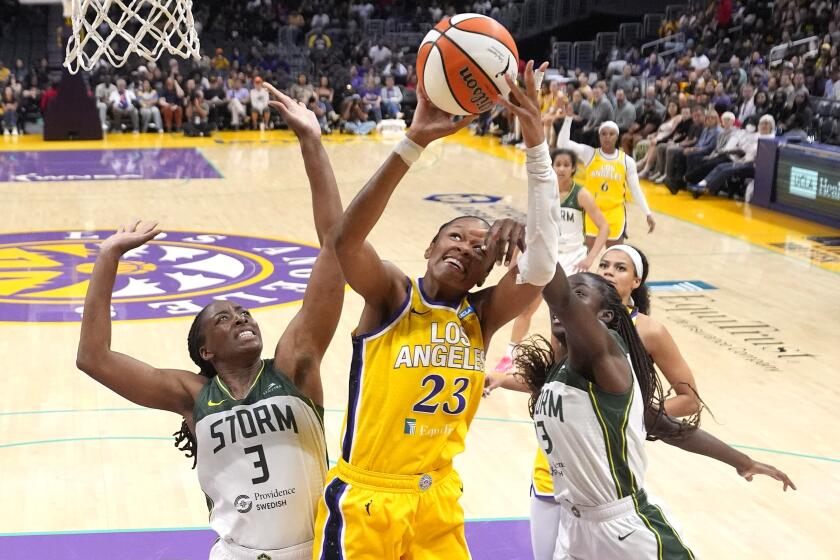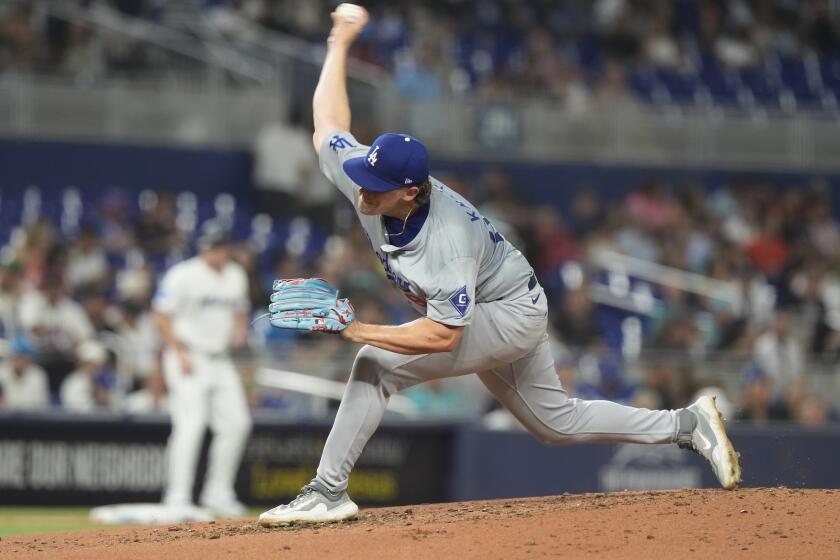An Angels offensive on updating defense

As the Angels prepared for the 2002 World Series, bench coach Joe Maddon looked at the spray charts and came to a radical conclusion: If the Angels wanted to align their defense based on where Barry Bonds most commonly hit the ball, they should play three infielders and four outfielders.
The Angels ultimately decided not to play Bonds that way, although Manager Mike Scioscia said they were “a couple pitches away” from deploying the scheme in certain scenarios. In 2005, Maddon left to manage the Tampa Bay Rays, who have been at the forefront of baseball’s shift toward unconventional fielding alignments.
The Angels are joining that trend this season, adding personnel and compiling data in a new-age approach to an age-old issue: How can a team position its fielders where the batter is most likely to hit the ball?
“It’s not revolutionary,” Scioscia said.
The exaggerated shifts for dead-pull hitters — three infielders on the right side of the infield against David Ortiz, for instance — have been around for decades. Dodgers Manager Don Mattingly recalls being frustrated two decades ago when he would hit a line drive up the middle against the Oakland Athletics only to discover A’s manager Tony La Russa had an infielder standing right there to catch it.
What is new is the tendency to shift fielders in almost any situation, against virtually every batter. The shifts vary according to the pitcher, the count and the game situation, and they can involve as little as a couple of steps.
“We’ve found it’s far more shading than shifting,” Scioscia said.
The Angels’ front office took note of how frequent shading had contributed to the success last season of the Rays, Pittsburgh Pirates and Boston Red Sox. However, the front office could have collected all the data in the world and it would not have mattered if the manager and coaches declined to use it.
“I’ll credit Mike Scioscia for leading this,” Angels assistant general manager Matt Klentak said. “Mike was all about this, from the early stages of the off-season.”
The Angels added three employees — player information coach Rick Eckstein, player information coordinator Nick Francona and advance scouting coordinator Jeremy Zoll — to gather and analyze data and prepare recommendations for players and coaches.
“In the past, we knew the batter and we knew how we would pitch him. Now we have more information,” Angels bench coach Dino Ebel said. “Instead of using [a player’s last] 200 at-bats, now we’re using 1,000 at-bats, and 2,000 at-bats.”
The Red Sox saved 15 runs using shifts last season, according to the Wall Street Journal. That means two or three runs per month. But Angels General Manager Jerry Dipoto said the impact of the shifts can be felt in every game — for example, with the extra out or two that enables a starting pitcher to last one more inning and enables a team to bypass the less reliable middle relievers and proceed directly to the setup men and closer.
Although the Angels tried to match up scouting reports and spray charts to their roster last year — building a fly-ball pitching staff with the idea that outfielders Mike Trout and Peter Bourjos could run down just about everything — Dipoto said the team did not take that approach this year.
“We’re not trying to build a staff to a report,” Dipoto said. “We’re trying to build a report to a staff. We’re trying to make sure that, where our pitchers throw the ball, we’ll be there to get results.”
During spring training, analytics staffers armed with tape measures stood on fields for hours, demonstrating to coaches how the data might play out in real life.
From the first day of drills, when pitchers took fielding practice, they did so with shifting infielders behind them. In the minor leagues, the Angels are directing infielders to shift and shade based on available data so that the movements will not be foreign to them when they arrive in Anaheim.
The Angels are wary of loading down players with too much information, or of forbidding them to react to what they see on the field.
“It comes down to instinct,” second baseman Howie Kendrick said. “But the numbers don’t lie, the history and the patterns.”
Albert Pujols, the Angels’ first baseman, did not care to discuss the issue. “I don’t care about shifts,” he said. “It’s overrated.”
However, Kendrick noted Pujols’ ability to hit to right field when the defense shifts too far toward left field. And former Angels shortstop David Eckstein, who played with Pujols in St. Louis, said the Cardinals could put three infielders on the left side because Pujols was blessed with range to plug the hole between first base and second base, yet still get back to first base to catch a throw.
John McDonald, the Angels’ 39-year-old veteran backup infielder, played for the World Series champion Red Sox last season. McDonald appreciates the data-based shifts but said he is interested to see how players respond.
Ortiz, for instance, is so used to seeing three infielders on the right side that he has become adept at hitting the other way, depending on the game situation.
“If you shift on him with runners in scoring position, he’s taking his RBI,” McDonald said. “He’s not worried about hitting the ball out of the ballpark.”
McDonald has a career .327 slugging percentage. When he bats, he said, he is used to seeing the right fielder creep forward.
“He’s still there,” McDonald said. “I still can’t hit it over his head.”
Twitter: @BillShaikin
McDonald has a career .327 slugging percentage. When he bats, he said, he is used to seeing the right fielder creep forward.
“He’s still there,” McDonald said. “I still can’t hit it over his head.”
Twitter: @BillShaikin
More to Read
Go beyond the scoreboard
Get the latest on L.A.'s teams in the daily Sports Report newsletter.
You may occasionally receive promotional content from the Los Angeles Times.
